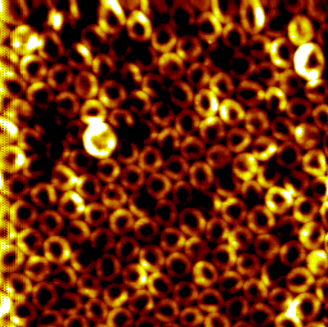A modified nanosphere lithographic method for producing arrays of silanized structures at silicon surfaces is described. Polystyrene (PS) particles (600 nm or 1000 nm in diameter) were self-assembled onto a silicon substrate to form a hexagonal close-packed pattern. The resultant patterned surface was then exposed to a solution of 3-aminopropyltriethoxysilane (APTS), which deposited gradually in the interstitial voids of the PS particle array. When such a surface was sonicated in toluene to dislodge the PS particles, a mesoporous network containing truncated PS nanorings/shells was produced. Gold nanoparticles or DNA-capped gold nanoparticles, which are both negatively charged, can be electrostatically attached onto the PS/APTS nanoring array. Atomic force microscopy (AFM) was used to image the surface pattern and structure after each step of the procedure, while X-ray photoelectron spectra (XPS) and UV-visible spectrometry were used to determine the composition of the surface patterns. The mechanisms for forming the PS/APTS nanostructures are discussed. These structures could potentially be used as biosensors, heterogeneous catalysts, and functionalized nano-devices.

You have access to this article
 Please wait while we load your content...
Something went wrong. Try again?
Please wait while we load your content...
Something went wrong. Try again?


 Please wait while we load your content...
Please wait while we load your content...